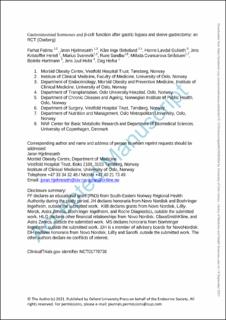| dc.contributor.author | Fatima, Farhat | |
| dc.contributor.author | Hjelmesæth, Jøran Sture | |
| dc.contributor.author | Birkeland, Kåre Inge | |
| dc.contributor.author | Gulseth, Hanne Løvdal | |
| dc.contributor.author | Hertel, Jens Kristoffer | |
| dc.contributor.author | Svanevik, Marius | |
| dc.contributor.author | Sandbu, Rune | |
| dc.contributor.author | Småstuen, Milada Cvancarova | |
| dc.contributor.author | Hartmann, Bolette | |
| dc.contributor.author | Holst, Jens Juul | |
| dc.contributor.author | Hofsø, Dag | |
| dc.date.accessioned | 2021-11-09T12:00:04Z | |
| dc.date.available | 2021-11-09T12:00:04Z | |
| dc.date.created | 2021-09-07T09:30:13Z | |
| dc.date.issued | 2021-08-03 | |
| dc.identifier.issn | 0021-972X | |
| dc.identifier.issn | 1945-7197 | |
| dc.identifier.uri | https://hdl.handle.net/11250/2828671 | |
| dc.description.abstract | Context Whether Roux-en-Y gastric bypass (RYGB) and sleeve gastrectomy (SG) differentially affect postprandial gastrointestinal hormones and β-cell function in type 2 diabetes remains unclear. Objective To compare gastrointestinal hormones and β-cell function assessed by an oral glucose tolerance test (OGTT) 5 weeks and 1 year after surgery hypothesizing higher GLP-1 levels and greater β-cell response to glucose after RYGB than after SG. Design, Setting, Patients, and Interventions Randomized, triple blind, single-center trial at a tertiary care center in Norway. Primary outcomes; diabetes remission and IVGTT derived β-cell function. Participants with obesity and type 2 diabetes allocated (1:1) to RYGB or SG. Main outcome measures Gastrointestinal hormone profiles and insulin secretion [β-cell glucose sensitivity (β-GS)] derived from 180 minutes OGTTs. Results 106 patients (67% women), mean (SD) age 48 (10) years. Diabetes remission rates at 1-year were higher after RYGB than after SG, 77% versus 48%, p = 0.002. Incremental area under the curve (iAUC0-180) glucagon-like peptide-1 (GLP-1) and β-GS increased more after RYGB than after SG, 1-year between-group difference 1173 pmol/l*min (95% CI 569 to 1776), p = 0.0010, and 0.45 pmol/kg/min/mmol (95% CI 0.15 to 0.75), p = 0.0032, respectively. Post-surgery, fasting and postprandial ghrelin levels were higher and decremental AUC0-180 ghrelin, iAUC0-180 glucose-dependent insulinotropic polypeptide, and iAUC0-60 glucagon were greater after RYGB than after SG. Diabetes remission at 1 year was associated with higher β-GS and higher GLP-1 secretion. Conclusions RYGB was associated with greater improvement in β-cell function and higher postprandial GLP-1 levels than SG. | en_US |
| dc.description.sponsorship | Funding for the study was provided by the Morbid Obesity Centre, Vestfold Hospital Trust, Tønsberg, Norway. | en_US |
| dc.language.iso | eng | en_US |
| dc.publisher | Oxford University Press | en_US |
| dc.relation.ispartofseries | Journal of Clinical Endocrinology and Metabolism; | |
| dc.subject | Gastric bypasses | en_US |
| dc.subject | Sleeve gastrectomy | en_US |
| dc.subject | Gastrointestinal hormones | en_US |
| dc.subject | Glucagon-like peptide 1 | en_US |
| dc.subject | Type 2 diabetes | en_US |
| dc.subject | Obesity | en_US |
| dc.title | Gastrointestinal Hormones and β-Cell Function After Gastric Bypass and Sleeve Gastrectomy: A Randomized Controlled Trial (Oseberg) | en_US |
| dc.title.alternative | Gastrointestinal hormones and β-cell function after gastric bypass and sleeve gastrectomy: an RCT (Oseberg) | en_US |
| dc.type | Peer reviewed | en_US |
| dc.type | Journal article | en_US |
| dc.description.version | acceptedVersion | en_US |
| dc.rights.holder | © The Author(s) 2021. | en_US |
| dc.source.articlenumber | dgab643 | en_US |
| cristin.ispublished | true | |
| cristin.fulltext | postprint | |
| cristin.qualitycode | 2 | |
| dc.identifier.doi | https://doi.org/10.1210/clinem/dgab643 | |
| dc.identifier.cristin | 1931838 | |
| dc.source.journal | Journal of Clinical Endocrinology and Metabolism | en_US |
| dc.source.pagenumber | 1-27 | en_US |
